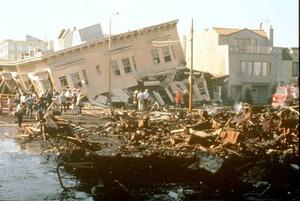DisastersGeologists push for earthquake early warning system despite costs
Geologists on the West Coast are actively pushing for an earthquake early warning system, similar to the one deployed in Japan; the Japanese warning system helped save lives as it gave people valuable extra time to prepare before the devastating 9.0 magnitude earthquake and tsunami hit; scientists want to place a similar network of data transmitters and information receivers along fault lines up and down the West Coast; geologists fear that a major impediment to the installation of the system would be its cost during times of fiscal austerity; the system would take roughly ten years to build and an estimated $145 million, making the project nearly impossible to undertake without federal funding

An early warning system could save many lives // Source: chattahbox.com
Geologists on the West Coast are actively pushing for an earthquake early warning system, similar to the one deployed in Japan. The Japanese warning system helped save lives as it gave people valuable extra time to prepare before the devastating 9.0 magnitude earthquake and tsunami hit.
Scientists want to place a similar network of data transmitters and information receivers along fault lines up and down the West Coast.
The system would provide roughly thirty seconds of advance warning before an earthquake is about to strike, which is enough time to slow down trains so they do not derail, allow residents to duck and cover, prevent planes from taking off or landing, and allow factories to shut down dangerous equipment.
Geologists fear that a major impediment to the installation of the system would be its cost – roughly $20 million a year – during times of fiscal austerity.
Doug Given, an earthquake early-warning coordinator with the U.S. Geological Survey (USGS), said, “We’d like to move forward, but the budget is a problem. I hope it won’t take a killer quake to build the system.”
According to Bill Steele, a seismologist at the University of Washington, the early-warning system would be helpful for three types of earthquakes that the West Coast experiences.
Off the coast of Washington and Oregon lies the Cascadia subduction zone which is capable of producing a massive earthquake like the one that just occurred in Japan.
Steele says, “When the Cascadia subduction zone ruptures again, this system could provide four minutes of warning, in an ideal case, that strong shaking is headed to the population centers of western Washington and Oregon.”
“It could also speed tsunami warnings to coastal communities,” he added.
The warning system could also give ten seconds of advance warning before tremors from an earthquake deep below Puget Sound hit population centers.
Cities located near the epicenter of a shallow crustal earthquake would not have much warning, but Steele says that residents could receive as much as thirty seconds of warning depending on where the earthquake’s epicenter was located.
In Japan, Tokyo received thirty seconds of advance warning, giving people valuable time to prepare, while Sendai, a city located near the epicenter, received five to ten seconds of warning.
p“We don’t know when the next damaging quake will happen. But when it does, we’ll wish we had an early-warning system,” said Richard Allen, the associate director of the Seismological Laboratory at the University of California, Berkeley.
“It’s a proven system; they just did it in Japan,” Allen said.
Allen added that ideally the early warning system part of a broader set of earthquake preparedness measures like strong building codes and emergency plans.
Geologists and scientists are hoping to raise funds to build a prototype to drum up support for the system.
But the actual system would take roughly ten years to build and an estimated $145 million, making the project nearly impossible to undertake without federal funding.
